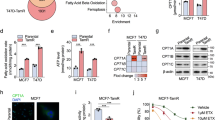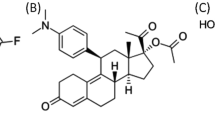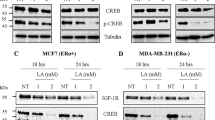Abstract
Overexpression of the lipogenic enzyme fatty acid synthase (FAS) is a common molecular feature in subsets of sex-steroid-related tumors including endometrium and breast carcinomas that are associated with poor prognosis. Pharmacological inhibition of tumor-associated FAS hyperactivity is under investigation as a chemotherapeutic target. We examined the effects of the mycotoxin cerulenin (a covalent FAS inactivator), and the novel small compound C75 (a slow-binding FAS inhibitor) on estradiol (E2)- and tamoxifen (TAM)-stimulated ER-driven molecular responses in Ishikawa cells, an in vitro model of well-differentiated human endometrial carcinoma. We evaluated the effects of FAS inhibition on E2- and TAM-induced estrogen receptor (ER) transcriptional activity by using transient cotransfection assays with an estrogen-response element reporter construct (ERE-Luciferase). Antiestrogenic effects of cerulenin and C75 were observed by dose-dependent inhibition of E2-stimulated ERE-dependent transcription, whereas FAS inhibitors did not significantly increase the levels of ERE transcriptional activity in the absence of E2. Moreover, pharmacological blockade of FAS activity completely abolished TAM-stimulated ERE activity. To address the reliability of transient transfection assays, the effects of FAS inhibitors on E2-inducible gene products were evaluated. FAS blockade induced a dose-dependent decrease in E2-inducible alkaline phosphatase activity. E2-stimulated accumulation of progesterone receptor (PR) and HER-2/neu oncogene was abolished in the presence of FAS blockers. FAS inhibition also resulted in a marked downregulation of E2-stimulated ERα expression, and noticeably impaired E2-induced ERα nuclear accumulation. A dose-dependent decrease in cell proliferation and cell viability was observed after FAS blockade. A Cell Death ELISA, detecting DNA fragmentation, demonstrated that FAS inhibitors stimulated apoptosis of Ishikawa cells. The analysis of critical E2- and TAM-related cell cycle proteins revealed an increase of both the expression and the nuclear accumulation of cyclin-dependent kinase inhibitors p21WAF1/CIP1 and p27Kip1 following FAS inhibition. To rule out non-FAS cerulenin- and C75-related effects, we finally monitored ER signaling after silencing of FAS gene expression using the highly sequence-specific mechanism of RNA interference (RNAi). The concentrations of E2 and TAM inducing half-maximal ERE activity (EC50) dramatically increased (>100 times) in FAS RNAi-transfected Ishikawa cells. Moreover, depletion of FAS by RNAi also caused loss of ERα expression, downregulation of PR, and accumulation of p21WAF1/CIP1 and p27Kip1 in E2-stimulated Ishikawa cells. If chemically stable FAS inhibitors or cell-selective vector systems able to deliver RNAi targeting FAS gene demonstrate systemic anticancer effects in vivo, our results render FAS as a novel target for the prevention and treatment of endometrial carcinoma.
This is a preview of subscription content, access via your institution
Access options
Subscribe to this journal
Receive 50 print issues and online access
$259.00 per year
only $5.18 per issue
Buy this article
- Purchase on Springer Link
- Instant access to full article PDF
Prices may be subject to local taxes which are calculated during checkout




Similar content being viewed by others
References
Albert JL, Sundstrom SA and Lyttle CR . (1990). Cancer Res., 50, 3306–3310.
Alo PL, Visca P, Marci A, Mangoni A, Botti C and Di Tondo U . (1996). Cancer, 77, 474–482.
Alo PL, Visca P, Trombetta G, Mangoni A, Lenti L, Monaco S, Botti C, Serpieri DE and Di Tondo U . (1999). Tumori, 85, 35–40.
Atanaskova N, Keshamouni VG, Krueger JS, Schwartz JA, Miller F and Reddy KB . (2002). Oncogene, 21, 4000–4008.
Bamberger AM, Riethdorf L, Milde-Langosch K, Bamberger CM, Thuneke I, Erdmann I, Schulte HM and Loning T . (1999). Virchows Arch., 434, 423–428.
Barsalou A, Gao W, Anghel SI, Carriere J and Mader S . (1998). J. Biol. Chem., 73, 17138–17146.
Beato M, Chavez S and Truss M . (1996). Steroids, 61, 240–251.
Bunone G, Briand PA, Miksicek RJ and Picard D . (1996). EMBO J., 15, 2174–2183.
Cariou S, Donovan JC, Flanagan WM, Milic A, Bhattacharya N and Slingerland JM . (2000). Proc. Natl. Acad. Sci. USA, 97, 9042–9046.
Chalbos D, Joyeux C, Galtier F and Rochefort H . (1992). J. Steroid Biochem. Mol. Biol., 43, 223–228.
Christie WW, Hunter ML and Clegg RA . (1981). Biochim. Biophys. Acta, 666, 284–290.
Colacurci N, De Seta L, De Franciscis P, Mele D, Fortunato N and Cassese S . (2000). Panminerva Med., 42, 45–47.
Cosman F and Lindsay R . (1999). Endocr. Rev., 20, 418–434.
De Schrijver E, Brusselmans K, Heyns W, Verhoeven G and Swinnen JV . (2003). Cancer Res., 63, 3799–3804.
Dils R and Carey EM . (1975). Methods Enzymol., 35, 74–83.
Elbashir SM, Harborth J, Lendeckel W, Yalcin A, Weber K and Tuschl T . (2001). Nature (London), 411, 494–498.
Escot C, Joyeux C, Mathieu M, Maudelonde T, Pages A, Rochefort H and Chalbos D . (1990). J. Clin. Endocrinol. Metab., 70, 1319–1324.
Evans RM . (1988). Science, 240, 889–895.
Favata MF, Horiuchi KY, Manos EJ, Daulerio AJ, Stradley DA, Feeser WS, Van Dyk DE, Pitts WJ, Earl RA, Hobbs F, Copeland RA, Magolda RL, Scherle PA and Trzaskos JM . (1998). J. Biol. Chem., 273, 18623–18632.
Favoni RE and de Cupis A . (1998). Trends Pharmacol. Sci., 19, 406–415.
Foster JS and Wimalasena J . (1996). Mol. Endocrinol., 10, 488–498.
Gallo MA and Kaufman D . (1997). Semin. Oncol., 24 (1 Suppl 1), 71–80.
Gansler TS, Hardman III W, Hunt DA, Schaffel S and Hennigar RA . (1997). Hum. Pathol., 28, 686–692.
Goldstein SR . (2000). Eur. J. Cancer, 36 (Suppl 4), 54–56.
Harborth J, Elbashir SM, Bechert K, Tuschl T and Weber K . (2001). J. Cell Sci., 114, 4557–4565.
Hata H, Hamano M, Watanabe J and Kuramoto H . (1998). Oncology, 55 (Suppl 1), 35–44.
Heemers H, Maes B, Foufelle F, Heyns W, Verhoeven G and Swinnen JV . (2001). Mol. Endocrinol., 15, 1817–1828.
Holinka CF, Hata H, Gravanis A, Kuramoto H and Gurpide E . (1986). J. Steroid Biochem., 25, 781–786.
Jamil A, Croxtall JD and White JO . (1991). J. Mol. Endocrinol., 6, 215–221.
Jensen V, Holm-Nielsen P and Melsen F . (1993). Breast Cancer Res. Treat., 27, 1–2.
Joyeux C, Rochefort H and Chalbos D . (1989). Mol. Endocrinol., 3, 681–686.
Kalkhoven E, Kwakkenbos-Isbrucker L, de Laat SW, van der Saag PT and van der Burg B . (1994). Mol. Cell Endocrinol., 102, 45–52.
Kato S, Endoh H, Masuhiro Y, Kitamoto T, Uchiyama S, Sasaki H, Masushige S, Gotoh Y, Nishida E, Kawashima H, Metzger D and Chambon P . (1995). Science, 270, 1491–1494.
Katzenellenbogen JA, O'Malley BW and Katzenellenbogen BS . (1996). Mol. Endocrinol., 10, 119–131.
Kawata M . (2001). Arch. Histol. Cytol., 64, 353–368.
Kim EK, Miller I, Landree LE, Borisy-Rudin FF, Brown P, Tihan T, Townsend CA, Witters LA, Moran TH, Kuhajda FP and Ronnett GV . (2002). Am. J. Physiol. Endocrinol. Metab., 283, 867–879.
Krishna PLB and Pezzuto JM . (2001). Cancer Res., 61, 6137–6144.
Kuhajda FP . (2000a). Nutrition, 16, 202–208.
Kuhajda FP, Pizer ES, Li JN, Mani NS, Frehywot GL and Townsend CA . (2000b). Proc. Natl. Acad. Sci. USA, 97, 3450–3454.
Kumar MV, Shimokawa T, Nagy TR and Lane MD . (2002). Proc. Natl. Acad. Sci. USA, 99, 1921–1925.
Kusakabe T, Maeda M, Hoshi N, Sugino T, Watanabe K, Fukuda T and Suzuki T . (2000). J. Histochem. Cytochem., 48, 613–622.
Lasset C, Bonadona V, Mignotte H and Bremond A . (2001). Lancet, 357, 66–67.
Lessey BA, Ilesanmi AO, Castelbaum AJ, Yuan L, Somkuti SG, Chwalisz K and Satyaswaroop PG . (1996). J. Steroid Biochem. Mol. Biol., 59, 31–39.
Li JN, Gorospe M, Chrest FJ, Kumaravel TS, Evans MK, Han WF and Pizer ES . (2001). Cancer Res., 61, 1493–1499.
Loftus TM, Jaworsky DE, Frehywot GL, Townsend CA, Ronnett GV, Lane MD and Kuhajda FP . (2000). Science, 288, 2379–2381.
Lupu R, Mehmi I, Atlas E, Tsai MS, Pisha E, Oketch-Rabah HA, Nuntanakorn P, Kennelly EJ and Kronenberg F . (2003). Int. J. Oncol., 23, 1407–1412.
Markogiannakis E, Georgoulias V, Margioris AN, Zoumakis E, Stournaras C and Gravanis A . (1997). Life Sci., 61, 1083–1095.
Menendez JA, Mehmi I, Atlas E, Colomer R and Lupu R . (2003). Int. J. Oncol., 24, 591–608.
Milgraum LZ, Witters LA, Pasternack GR and Kuhajda FP . (1997). Clin. Cancer Res., 3, 2115–2120.
Moche M, Schneider G, Edwards P, Dehesh K and Lindqvist Y . (1999). J. Biol. Chem., 274, 6031–6034.
Moelling K, Schulze T, Knoop MT, Kay J, Jupp R, Nicolaou G and Pearl LH . (1990). FEBS Lett., 261, 373–377.
Nishida M . (2002). Hum. Cell, 15, 104–117.
Nishida M, Kasahara K, Oki A, Satoh T, Arai Y and Kubo T . (1996). Hum. Cell, 9, 109–116.
Omura S . (1976). Bacteriol. Rev., 40, 681–697.
Perez L and Carrasco L . (1991). FEBS Lett., 280, 129–133.
Perlmann T and Evans RM . (1997). Cell, 90, 391–397.
Persson I . (2000). J. Steroid. Biochem. Mol. Biol., 74, 357–364.
Pisha E and Pezzuto JM . (1997). Methods Cell Sci., 19, 37–43.
Pizer ES, Chrest FJ, DiGiuseppe JA and Han WF . (1998a). Cancer Res., 58, 4611–4615.
Pizer ES, Jackisch C, Wood FD, Pasternack GR, Davidson NE and Kuhajda FP . (1996a). Cancer Res., 56, 2745–2747.
Pizer ES, Kurman RJ, Pasternack GR and Kuhajda FP . (1997). Int. J. Gynecol. Pathol., 16, 45–51.
Pizer ES, Lax SF, Kuhajda FP, Pasternack GR and Kurman RJ . (1998b). Cancer, 83, 528–537.
Pizer ES, Thupari J, Han WF, Pinn ML, Chrest FJ, Frehywot GL, Townsend CA and Kuhajda FP . (2000). Cancer Res., 60, 213–218.
Pizer ES, Wood FD, Heine HS, Romantsev FE, Pasternack GR and Kuhajda FP . (1996b). Cancer Res., 56, 1189–1193.
Planas-Silva MD and Weinberg RA . (1997). Mol. Cell. Biol., 17, 4059–4069.
Prall OW, Sarcevic B, Musgrove EA, Watts CK and Sutherland RL . (1997). J. Biol. Chem., 272, 10882–10894.
Price AC, Choi KH, Heath RJ, Li Z, White SW and Rock CO . (2001). J. Biol. Chem., 276, 6551–6559.
Roncari DA . (1974). Can. J. Biochem., 52, 221–230.
Rosenbaum Smith SM and Osborne MP . (2000). Am. J. Surg., 180, 249–251.
Sakamoto T, Eguchi H, Omoto Y, Ayabe T, Mori H and Hayashi S . (2002). Mol. Cell. Endocrinol., 192, 93–104.
Schwartz LB, Krey L, Demopoulos R, Goldstein SR, Nachtigall LE and Mittal K . (1997). Am. J. Obstet. Gynecol., 176 (1 Part 1), 129–137.
Shimokawa T, Kumar MV and Lane MD . (2002). Proc. Natl. Acad. Sci. USA, 99, 66–71.
Shiozawa T, Nikaido T, Nakayama K, Lu X and Fujii S . (1998). Mol. Hum. Reprod., 4, 899–905.
Shurbaji MS, Kalbfleisch JH and Thurmond TS . (1996). Hum. Pathol., 27, 917–921.
Simard J, Sanchez R, Poirier D, Gauthier S, Singh SM, Merand Y, Belanger A, Labrie C and Labrie F . (1997). Cancer Res., 57, 3494–3497.
Simon SM and Aderem A . (1992). J. Biol. Chem., 267, 3922–3931.
Swinnen JV, Esquenet M, Goossens K, Heyns W and Verhoeven G . (1997). Cancer Res., 57, 1086–1090.
Swinnen JV, Roskams T, Joniau S, Van Poppel H, Oyen R, Baert L, Heyns W and Verhoeven G . (2002). Int. J. Cancer, 98, 19–22.
Thupari JN, Landree LE, Ronnett GV and Kuhajda FP . (2002). Proc. Natl. Acad. Sci. USA, 99, 9498–9502.
Tsai M-J and O'Malley BW . (1995). Annu. Rev. Biochem., 63, 451–486.
Vance D, Goldberg I, Mitsuhashi O and Bloch K . (1972). Biochem. Biophys. Res. Commun., 48, 549–565.
Van Leeuwen FE, Benraadt J, Coebergh JW, Kiemeney LA, Gimbrere CH, Otter R, Schouten LJ, Damhuis RA, Bontenbal M, Diepenhorst FW, van den Belt-Dusebout AW and van Tinteren H . (1994). Lancet, 343, 448–452.
Wakil S . (1989). Biochemistry, 28, 4523–4530.
Webb P, Nguyen P, Shinsako J, Anderson C, Feng W, Nguyen MP, Chen D, Huang SM, Subramanian S, McKinerney E, Katzenellenbogen BS, Stallcup MR and Kushner PJ . (1998). Mol. Endocrinol., 12, 1605–1618.
Weiss L, Hoffmann GE, Schreiber R, Andres E, Fuchs E, Korber E and Kolb HJ . (1986). Biol. Chem. Hoppe Seyler, 367, 905–912.
Witkowski A, Rangan VS, Randhawa ZI, Amy CM and Smith S . (1991). Eur. J. Biochem., 198, 571–579.
Wortman MD, Clegg DJ, D'Alessio D, Woods SC and Seeley RJ . (2003). Nat. Med., 9, 483–485.
Ye Q, Chung LW, Li S and Zhau HE . (2000). Biochim. Biophys. Acta, 1493, 373–377.
Zamore PD, Tuschl T, Sharp PA and Bartel DP . (2000). Cell, 101, 25–33.
Acknowledgements
We thank Dr Ellen Pizer (Johns Hopkins University, Baltimore, MD, USA) for providing anti-FAS monoclonal antibody. JAM is the recipient of a Concept Award from the Evanston Northwestern Healthcare Breast Cancer Program and of a Translational Research Pilot Project from the Specialized Program of Research Excellence – SPORE – in Breast Cancer (National Cancer Institute). RL is the recipient of the Cnarlene and Robert Baizer foundation and the Carol Gollob Foundation for Breast Cancer Research.
Author information
Authors and Affiliations
Corresponding author
Rights and permissions
About this article
Cite this article
Menendez, J., Oza, B., Atlas, E. et al. Inhibition of tumor-associated fatty acid synthase activity antagonizes estradiol- and tamoxifen-induced agonist transactivation of estrogen receptor (ER) in human endometrial adenocarcinoma cells. Oncogene 23, 4945–4958 (2004). https://doi.org/10.1038/sj.onc.1207476
Received:
Revised:
Accepted:
Published:
Issue Date:
DOI: https://doi.org/10.1038/sj.onc.1207476
Keywords
This article is cited by
-
How cancer cells remodel lipid metabolism: strategies targeting transcription factors
Lipids in Health and Disease (2021)
-
Fluorene-9-bisphenol inhibits epithelial-mesenchymal transition of human endometrial cancer Ishikawa cells by repressing TGF-β signaling pathway
Environmental Science and Pollution Research (2019)
-
Fatty acid synthase regulates estrogen receptor-α signaling in breast cancer cells
Oncogenesis (2017)
-
Effects of Fatty Acid Synthase Inhibition by Orlistat on Proliferation of Endometrial Cancer Cell Lines
Targeted Oncology (2016)
-
Fatty acid synthase overexpression: target for therapy and reversal of chemoresistance in ovarian cancer
Journal of Translational Medicine (2015)



